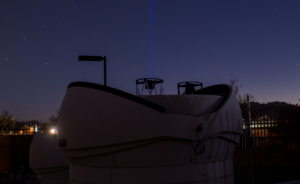“We wanted to develop a partnership with our suppliers that would invest them in our success,” said Mark LaPenna, Xenesis founder and CEO, told SpaceNews.
The revenue-sharing model is aimed at reducing the cost of Xenesis’ initial on-orbit demonstration. “We are able to buy 100% of our technology at true manufactured cost,” LaPenna said.
Xenesis is scheduled to begin demonstrating the performance of its optical terminal in 2022 on Bartolomeo, Airbus Defence and Space’s external research platform on the International Space Station.
Xenesis also adopted its revenue-sharing model to discourage key suppliers from backing alternative optical communications constellations.
“When the industry catches wind of what we’re going to be offering, there will be a lot of copycat products,” LaPenna said. “Some of our competitors are very well heeled. They will be able to pivot to compete with us by spending money.”
Suppliers are embracing the revenue-sharing model too.
“From a subsystem supplier’s standpoint, it’s great to be a partner not a vendor,” said Dave Strobel, Space Micro president and CEO. “We are sharing a lot of our business development and marketing insight. Also, revenue sharing is obviously pretty darn attractive from the financial standpoint in the out years.”
Xenesis was founded in 2017 to resolve a problem LaPenna discovered while attempting to establish another startup to provide extremely accurate global flight tracking.
“There was a massive hole in the market in providing low-Earth orbiting satellite operators and constellation operators a healthy amount of low-latency bandwidth at a low cost,” LaPenna said.
Xenesis’ plans to begin filling that hole with an optical communications service called Xen-Link.
“We’re actually able to deliver an entire dedicated architecture at zero [capital expenditure] to our customer and get them in a situation where they can significantly reduce their cost of acquisition of the very thing that they sell, whether it be Earth imagery, sensing or any other concept of operations,” LaPenna said.
Xenesis is working with early Xen-Link customers to understand their requirements for Xen-Hub optical terminals built by San Diego-based Space Micro to integrate with their satellites. Based on each customer’s orbital mechanics and flight path, Xenesis, Geost and PlaneWave also are establishing the ground architecture.
“We’re building a dedicated architecture for each customer,” LaPenna said.
In the long run, Xenesis plans to create Intercessor, an optical mesh network to offer data backhaul.
“Between now and 2027, we see a clear path to providing enterprise-level customers and mobile network operators a service offering that allows them to drive the cost down, so that they can compete with the Starlink, Kuipers and OneWebs of the world,” LaPenna said. “We’ll leave the job of connecting the unconnected to the incumbents and we’ll deliver to them the force multiplier they need to do exactly that.”
Long before 2027, companies expect optical communications to proliferate as satellite owners and operators adopt the technology.
“We’ve looked at a number of optical ground station opportunities over the years, but there’s always this chicken and egg problem,” said Tony Glecker, president of Tuscon, Arizona-based Geost. “You can’t sell the optical service without putting in the big ground infrastructure. The unique thing that Xenesis has brought to the game that made us want to be part of the partnership is the fact that they’re thinking about the whole infrastructure.”
Richard Hedrick, president and CEO of PlaneWave Instruments of Adrian, Michigan, agreed.
“I’ve seen the [optical communications] market trying to figure out how it can come into existence,” Hedrick said. “We have been dealing for years with different companies.” The winner is going to be the company that develops the whole optical communications infrastructure, he added.



